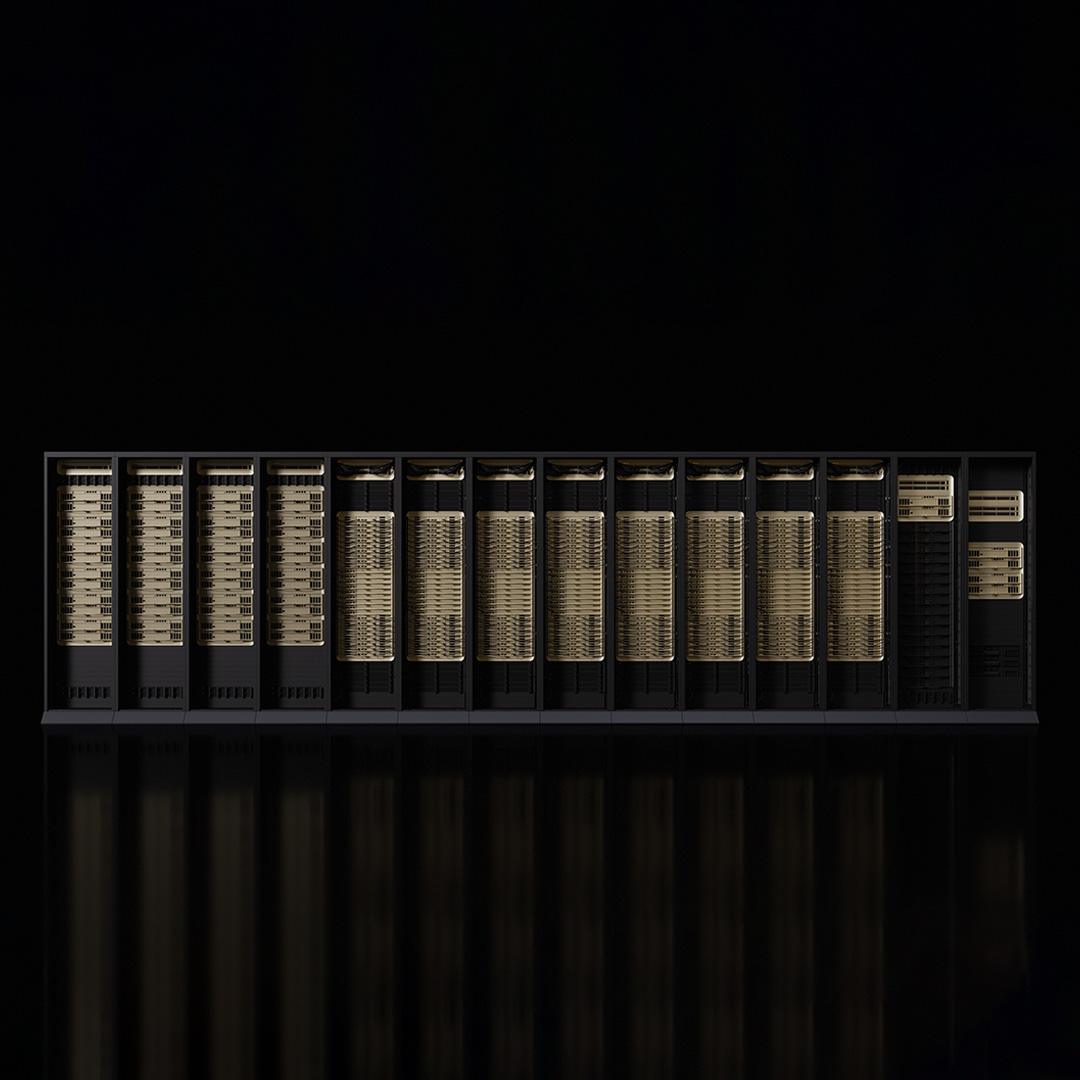Unleashing Gaming and AI Innovation Across Consumer Device Markets with New Arm GPUs

Arm GPUs are integral to people’s daily digital lives, powering everything from immersive gaming experiences on today’s smartphones through to a range of AI-based experiences at the edge. To date, Arm’s partners have shipped over 10 billion GPUs and we have our industry-leading ecosystem to thank for this amazing achievement. These GPUs are present across a broad range of consumer devices, from smartphones and tablets to smart TVs and set-top boxes to smart watches and XR wearable devices.
This time last year, we announced our new 5th Gen GPU architecture along with a family of new GPUs. This included the Arm Immortalis-G720 GPU, which appeared in MediaTek’s Dimensity 9300 system-on-chip (SoC) platform that was subsequently adopted in flagship smartphone devices from leading OEMs vivo and OPPO.
This year, we are delighted to announce our second-generation family of GPUs that are built on our 5th Gen GPU architecture and forms a vital component in the Arm Compute Subsystems (CSS) for Client platform. These include the new Arm Immortalis-G925 GPU, Arm Mali-G725 GPU and Arm Mali-G625 GPU for a variety of consumer devices, from flagship smartphones and premium mobile handsets through to smartwatches and entry-level mobile devices. At the heart of these GPU designs are two clear focus areas:
- Enabling immersive visual experiences as part of the ongoing mobile gaming evolution; and
- Accelerating AI-based experiences across leading applications.
Leading gaming performance
Last year’s Immortalis-G720 beats the competition in most graphics benchmarks for peak performance (frames per second (fps)) and sustained performance for longer game play. We continue to drive this exceptional performance through Immortalis-G925, which is Arm’s highest performance and most efficient GPU ever. When compared on Arm Reference Platforms, Immortalis-G925 delivers 37 percent better performance (fps) than Immortalis-G720. Moreover, when providing gaming performance on par with Immortalis-G720, Immortalis-G925 uses 30 percent less power.
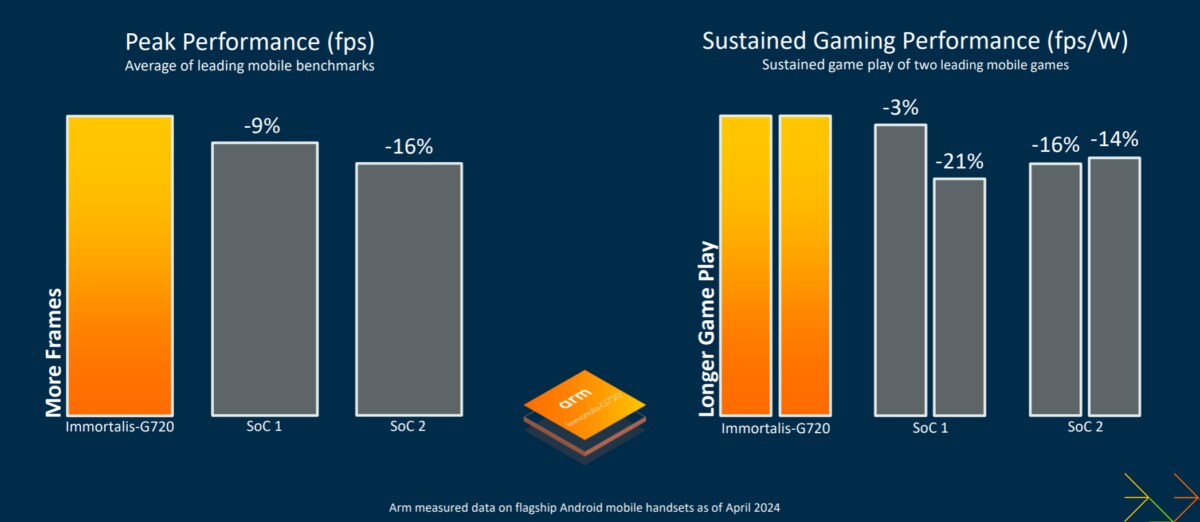
This exceptional performance extends to leading mobile games, with Immortalis-G925 providing 46 percent performance improvements, on average, compared to Immortalis-G720. Focusing on individual games, Genshin Impact is 49 percent more performant, while Roblox runs 46 percent faster. Other popular mobiles games offer performance improvements in the range of 29 to 72 percent, including Call of Duty Mobile, Diablo Immortal, the Day After Tomorrow, Fortnite and PUBG Mobile.
These levels of gaming improvements are incredible and will be meaningful to developers and, ultimately, gamers.
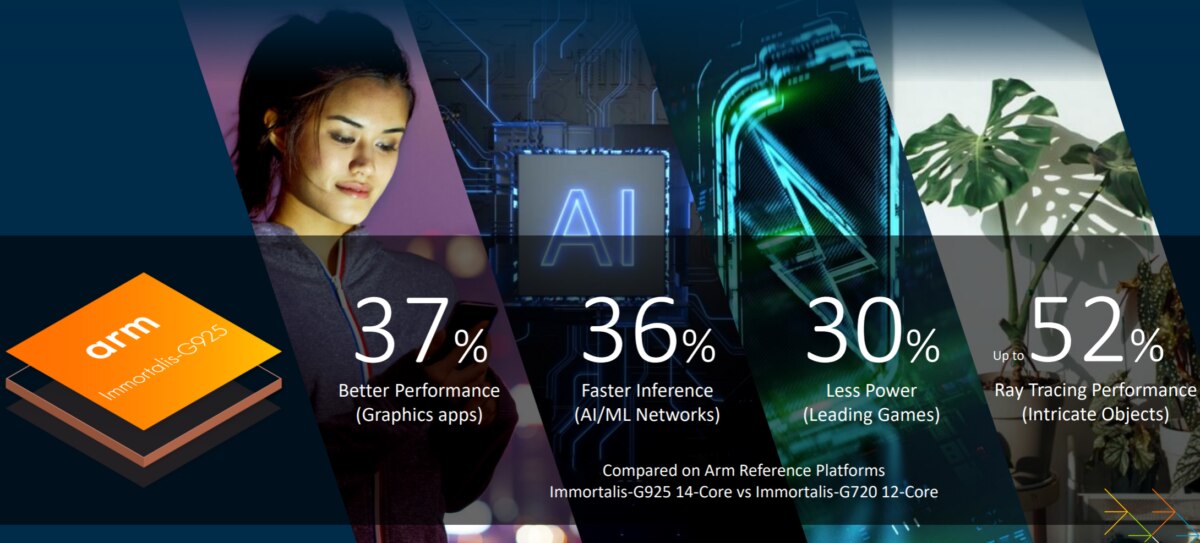
The ongoing quest for greater gaming realism
At Arm, we pay attention to the evolution in mobile gaming content trends, so our GPUs can address the needs of developers and ecosystem partners. Immortalis-G925, which is designed for the latest gaming techniques, features and trends, is no different. What ties these all together is a collective ecosystem-wide push for greater gaming realism.
Scene geometry – which adds greater definition to game objects, helps to create more realistic terrain and brings greater realism to game characters – has been growing across mobile gaming in recent years. In fact, leading games Fortnite and Genshin Impact have seen a 9 to 11 percent increase in geometry complexity year-on-year as developers strive for more scene detail and greater realism.
Complex fragment shading is a technique that is used to create more lifelike gaming through the texturing of objects and characters. It enables high-quality gaming effects, such as bloom, blur and physically based shading. On Fortnite and Genshin Impact, there has been an explosion in the time fragment shaders spend on the GPU, between 27 and 43 percent year-on-year.
Meeting this demand for more complex geometry, Immortalis-G925 introduces a new mechanism called fragment prepass. This is a graphics technique that removes the need for applications to do any object or primitive sorting and improves the efficiency of reducing overdraws when processing geometry workloads. Through fragment prepass, we have observed up to 43 percent reduction in render thread cycles due to the removal of object sorting. This leads to improved performance and power efficiency, as well as a reduction in the CPU load.
Since its introduction in the Arm Immortalis-G715 GPU, ray tracing – which helps to create more realistic shadows, reflections and advanced lighting effects – is becoming more prevalent. Immortalis-G925 is driving the push for improved ray tracing content, with up to 52 percent improvement in ray tracing performance with intricate objects. Through in-house testing on ray tracing content, we are making further ray tracing performance improvements. This includes 27 percent more performance while maintaining the same level of accuracy in the transparency of gaming scenes. Alternatively, developers could choose to slightly reduce the accuracy in the transparency of gaming scenes, but then obtain an impressive performance improvement of up to 52 percent along with a 57 percent reduction in memory traffic.
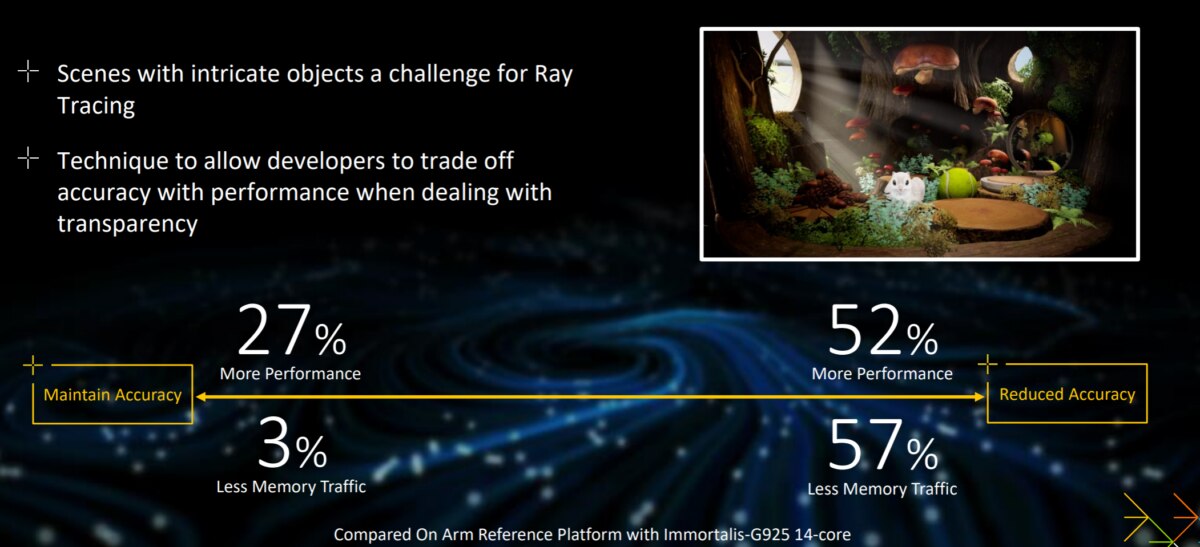
Increasing shader cores to support even more consumer markets
At Arm, we have looked at the increasing demands for performance from a variety of consumer device markets, like laptops, Chromebooks and gaming phones. Therefore, Immortalis-G925 now supports 50 percent more shader cores, taking our largest configuration on offer to 24 Cores compared to the maximum of 16 in the previous generation.
To scale to this performance point, the tiler throughout and command stream front-end (CSF) have undergone changes and optimizations. We have been able to double the tiler throughput and made several improvements in the CSF to speed up job dispatch to the shader cores, including hardware support for key commands and increasing the number of hardware interfaces.
The number of shader cores is scaled across our new GPUs. Immortalis-G925 is configured with 10 cores or more for high-performance consumer technology markets, like flagship smartphones. Mali-G725 scales between 6 to 9 cores and is targeted for premium mobile handsets. However, it still offers the same API support as Immortalis-G925, while delivering a compelling and immersive gaming experience for lower device tiers not targeted by Immortalis-G925. Mali-G625 is scalable between 1 and 5 cores and targets smartwatches and entry-level mobile devices.
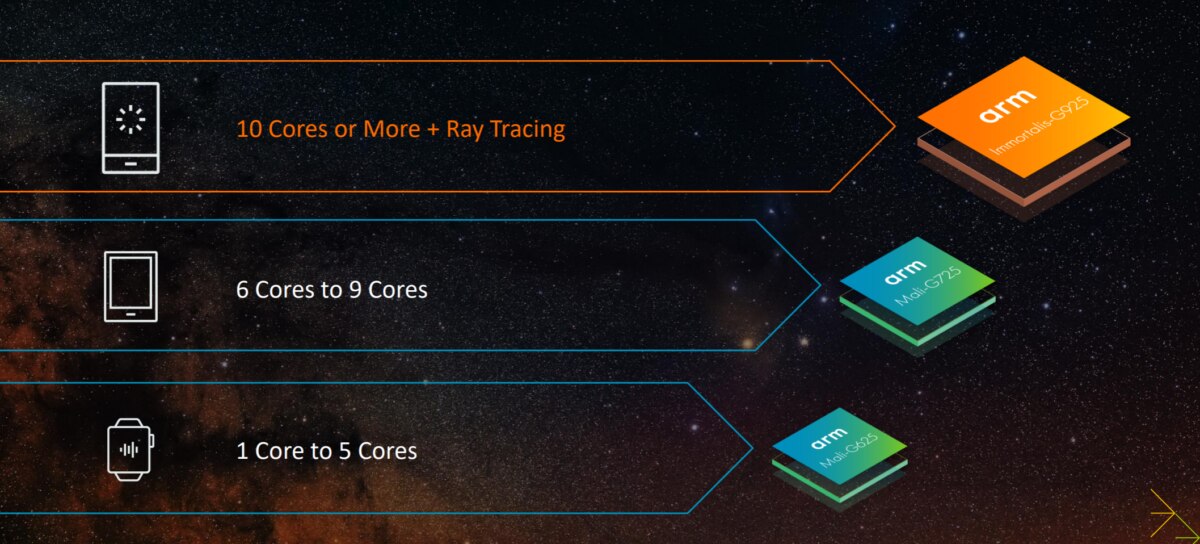
AI performance uplifts
As with previous generations, we continue to improve the performance and efficiency of AI workloads on our GPUs. As a key component of CSS for Client, Immortalis-G925 provides 36 percent faster inference across AI and ML networks compared to Immortalis-G720 in TSC23. While the majority of AI processing can take place on the CPU, the GPU offers acceleration capabilities for various AI use cases, including image classification, image segmentation, object detection, natural language processing, and speech to text.
As part of CSS for Client, Immortalis-G925 delivers a host of AI performance improvements across key use cases when compared to TCS23’s Immortalis-G720. In image processing, which includes segmentation and classification, Immortalis-G925 delivers an impressive 41 percent performance improvement. Meanwhile, in super sampling tasks, where developers can upscale an image using neural networks, it improves performance by just under 30 percent and with natural language processing and speech to text the performance improvement is an impressive 50 percent.
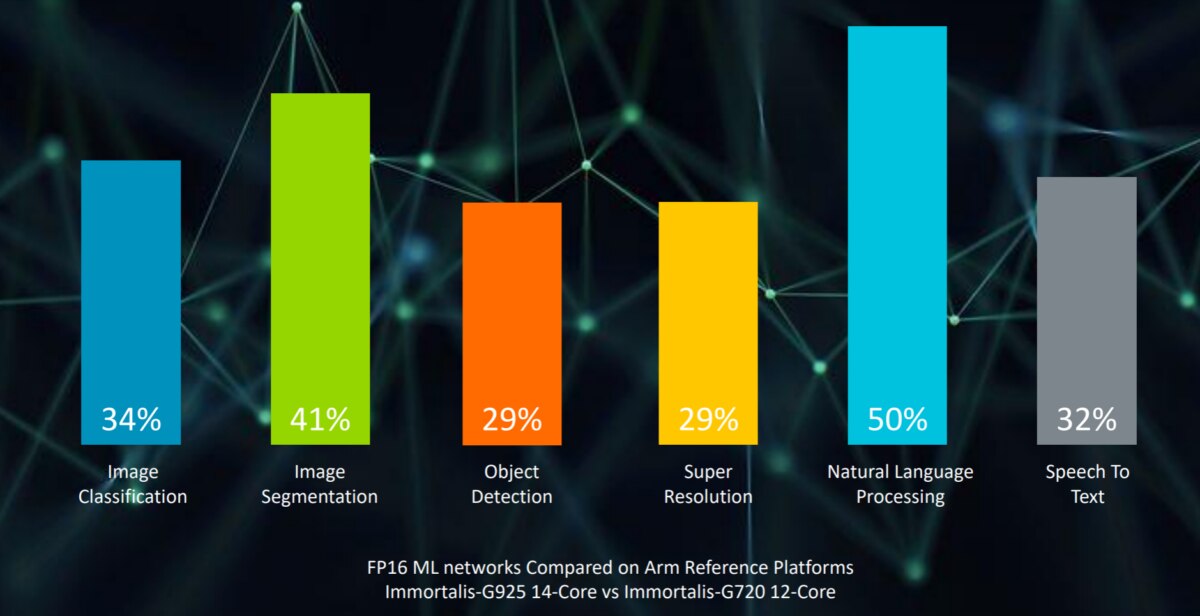
Arm is also working with leading ecosystem partners to improve AI performance. Through our collaboration with Unity, we are helping to bring int8 support into Sentis, which is the machine learning (ML) framework for Unity-based applications. Moving to int8 brings a 44 percent performance uplift with a smaller memory footprint for improved ML-based mobile gaming experiences.
Finally, as part of CSS for Client, we are co-designing and delivering a GPU physical implementation. Working with leading foundry partners, we have enabled a tape-out ready Immortalis-G925 physical implementation for 3nm. This helps our partners to unlock the full PPA (power, performance, area) benefits on the 3nm process, while shortening silicon development and deployment timelines through the production-ready silicon solution.
Advancing graphics through ecosystem collaborations
Alongside our latest GPUs, Arm is committed to working with our gaming ecosystem to bring advanced graphical features and capabilities.
We are working with Epic Games to enable its Unreal Engine 5 desktop renderer on Android. For developers, this ensures that desktop quality rendering and graphics are delivered by Immortalis and Mali GPUs on mobile devices. As part this work on the Unreal Engine 5 desktop renderer, the Lumen lighting solution for ray tracing has been optimized for Arm GPUs, especially those that support hardware-based ray tracing. Developers working with Lumen can use our best practice advice to manage scene complexity, update frequencies and probe settings that rival console quality lighting.
We are also working with Google and MediaTek on the Android Dynamic Performance Framework (ADPF), which is a powerful API from Google. ADPF empowers developers to optimize the user experience and performance of their applications based on real-time thermal-state information of mobile devices. In demanding applications, like mobile games, this can reduce power consumption, avoid overheating and extend play sessions. Through enabling ADPF on the Arm-powered Google Pixel 8 smartphone, our Steel Arms mobile gaming demo, which was showcased at Mobile World Congress (MWC) 2024, used 25 percent less energy per frame at a 35 percent faster frame rate.
Finally, Arm continues to maintain consistent ecosystem support for game developers through a range of GPU tools and resources. Arm Performance Studio builds on the success of Arm Mobile Studio by extending the analysis tools to support a range of new workloads, platforms and devices beyond mobile and the GPU, including CPUs for the server market and Arm Linux platforms. As part of Arm Performance Studio, we have added Arm Frame Advisor, which makes graphics profiling and optimizations more accessible to developers, enabling them to target their optimizations more accurately and get their software to market faster.
Built for next-generation AI and gaming experiences
As mobile gaming and AI workloads continue to evolve, the latest generation of Arm GPUs deliver exceptional performance and efficiency benefits for the very best user experiences. This continues the excellent momentum of previous Arm GPUs that are shipping in leading consumer devices and demonstrating outstanding peak and sustained gaming performance.
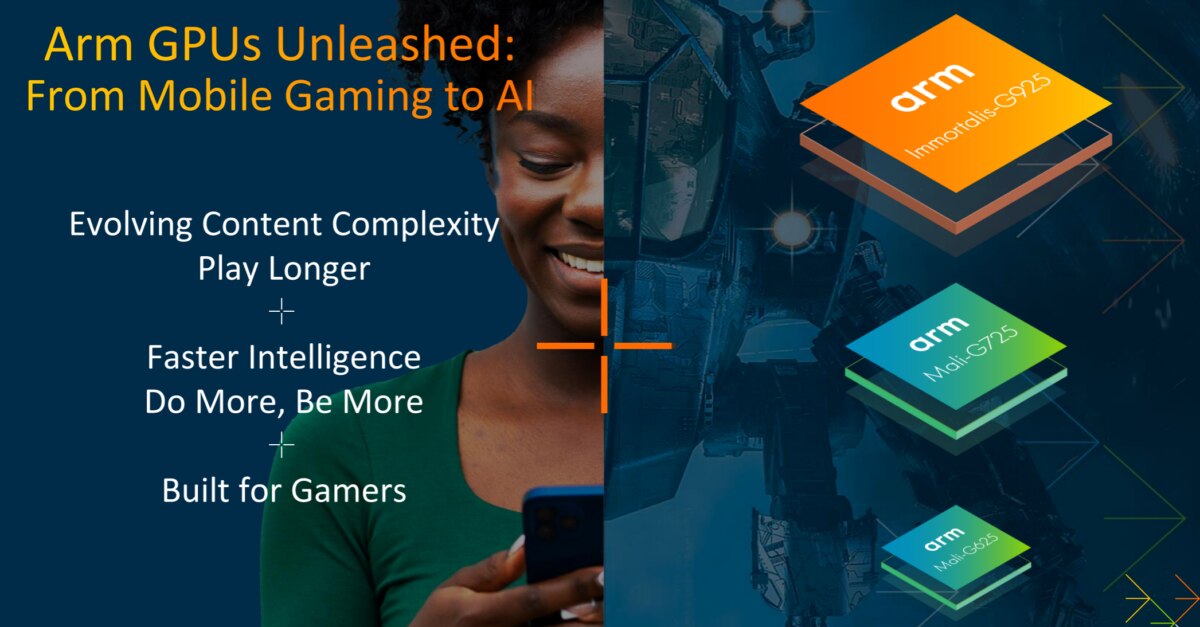
Through Immortalis-G925, Mali-G725 and Mali-G625, we are targeting a broad spectrum of consumer devices across different tiers, from flagship to entry-level, where we are seeing ever-increasing consumer and partner demands for more immersive mobile gaming and AI-based experiences. Our new GPUs meet these demands, delivering unprecedented levels of gaming and AI performance. This means faster, more immersive, more intelligent visual experiences for the millions of developers and billions of users worldwide who interact with Arm-based devices.
Any re-use permitted for informational and non-commercial or personal use only.




